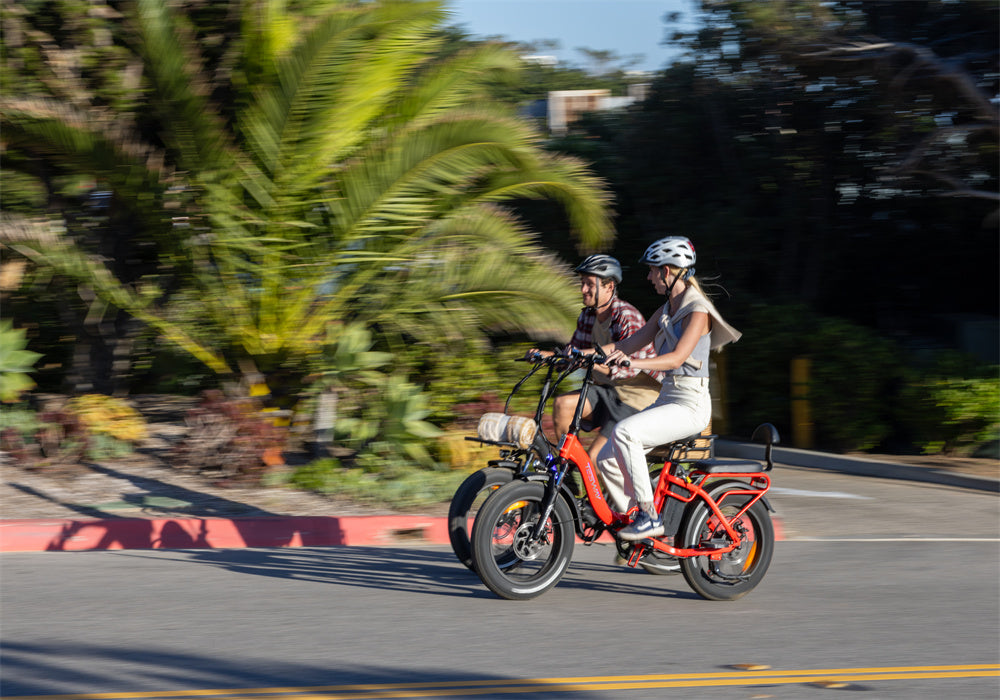Unlike traditional bicycles, e-bikes come equipped with an electric motor that aids in pedaling, providing a significant advantage when navigating the typically soft and uneven sand found at beaches.
Don't Forget to Check the Laws
The legality of riding electric bikes on beaches varies considerably depending on local laws and regulations, which can change from one county to another or even between different beaches within the same region. To avoid inadvertently breaking the law or facing fines, it's important to perform due diligence by checking with local beach authorities, park boards, or city regulations. Some beaches might allow e-bikes on designated paths or in specific areas during certain times of the year, while others may have strict prohibitions due to safety concerns or environmental preservation efforts. Understanding these rules beforehand can save you from unnecessary hassles and contribute to a pleasant and lawful beach riding experience.

Choosing the Right Electric Bike for Beach Riding
Selecting an e-bike for beach use requires careful consideration of several key features that enhance performance and durability in beach environments:
- Fat Tires: E-bikes with fat tires are highly recommended for beach rides as their wider and larger tires provide increased stability and are better suited to handle loose sand compared to standard tires.
- Corrosion Resistance: The beach environment is harsh with its salty air and moisture, which can cause rust and corrosion. Opt for an e-bike that is built with corrosion-resistant materials and coatings to extend the lifespan of your bike.
- Powerful Motor: An e-bike with a more powerful motor can be beneficial for beach riding, helping you to effortlessly cruise over soft patches of sand where a less powerful bike might bog down.

Best Practices for Beach Riding on an Electric Bike
To maximize enjoyment and minimize impact on your bike when riding on the beach, consider these best practices:
- Lower Tire Pressure: By lowering the air pressure in your tires, you increase the contact area of the tire with the ground, which improves grip and makes it easier to maneuver through soft sand.
- Rinse After Riding: Salt and sand can be damaging to mechanical and electrical components. It's essential to thoroughly rinse your e-bike with fresh water after each beach ride to remove these potentially harmful residues.
- Ride at Low Tide: The firmer sand found closer to the water line at low tide provides a more stable surface for riding. Plan your trips around the tidal schedules to take advantage of these optimal conditions.
- Watch for Pedestrians and Wildlife: Beaches are shared spaces frequented by families, joggers, and wildlife. Always maintain a cautious and respectful speed, and keep a safe distance from other beachgoers and animals to ensure safety for everyone.

Care After Beach Rides
Proper maintenance is crucial after riding an electric bike on the beach to ensure its longevity and performance. Here are detailed steps to follow after each beach ride:
-
Thorough Cleaning: Immediately after your ride, wash your e-bike thoroughly with fresh water to remove sand, salt, and other debris. Pay special attention to the chain, gears, and electrical components, which are particularly vulnerable to corrosion. Use a soft brush or cloth to gently scrub away any stubborn grime.
-
Dry Properly: After rinsing, dry your e-bike thoroughly to prevent rust. Use a clean, dry cloth to wipe down all surfaces. Allow the bike to air dry completely in a well-ventilated area before storing it. Avoid storing the bike while it is still damp, as this can encourage rust development.
-
Lubricate Moving Parts: Salt and sand can strip lubrication from moving parts, leading to increased wear and tear. After cleaning and drying your bike, apply a liberal amount of lubricant to the chain, gears, and any other moving components. Use a lubricant designed for bike chains, which can help repel moisture and prevent rust.
-
Check for Damage: Inspect your bike for any signs of wear or damage, such as rust spots, loose components, or frayed wires. Pay particular attention to the brake system and tires, as these are critical for safety and heavily exposed to beach elements. If you notice any issues, address them immediately to avoid further damage.
- Battery Care: Remove the battery before washing the bike and make sure it is stored in a cool, dry place. If the battery has been exposed to a lot of humidity or sand, wipe it down with a dry cloth. Check the battery terminals for any signs of corrosion or debris and clean them if necessary. Always recharge the battery according to the manufacturer's instructions.

Your Perfect Beach Bike Awaits You
Looking for the perfect electric bike for your beach adventures? TESWAY offers specialized e-bikes tailored for beach riding. Whether you prioritize style or functionality, we have the right fit for you. The S7 combines sleek design with robust features perfect for the beach. With sand-ready tires and a powerful motor, it offers effortless navigation and undeniable style. Ideal for travelers, the foldable eletric bike S5 is easy to transport and designed for long rides. Despite its compact size, it doesn't compromise on performance or durability.
Why Choose TESWAY?
TESWAY e-bikes are crafted from high-quality materials, ensuring durability against beach elements and providing a user-friendly experience. Whether you choose the dynamic S7 or the versatile S5, you’re set for memorable beach adventures.
Visit TESWAY today to find the beach electric bicycle that suits you best. Your next great ride awaits!
FAQs
Are e-bikes environmentally friendly?
E-bikes are more environmentally friendly than gasoline-powered vehicles. They emit no direct pollutants and can reduce traffic congestion and the carbon footprint associated with vehicle use.
How much do e-bikes typically cost?
The cost of e-bikes varies widely based on the type, features, and brand. Prices can range from $1,000 for basic models to over $10,000 for high-end versions with advanced features and materials.
What should I look for when buying an e-bike?
Consider the type of e-bike that suits your needs, the quality of the battery, motor strength, frame material, range, comfort, and the availability of after-sales service and parts. Test rides are also highly recommended.







Share:
Skip the DIY Hassle: Why Buying an E-Bike Beats Building Your Own
Why Fat Tire Biking Will Be Your New Favorite Outdoor Activity